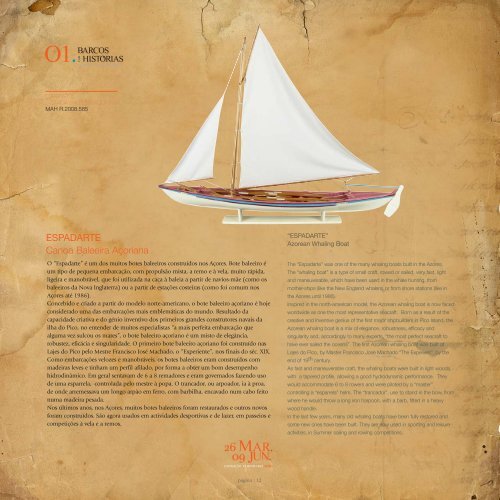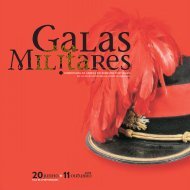Versão digital - Museu de Angra do Heroísmo
Versão digital - Museu de Angra do Heroísmo
Versão digital - Museu de Angra do Heroísmo
Create successful ePaper yourself
Turn your PDF publications into a flip-book with our unique Google optimized e-Paper software.
ESPADARTE<br />
_ CANOA BALEEIRA AÇORIANA<br />
MAH R.2008.585<br />
ESPADARTE<br />
Canoa Baleeira Açoriana<br />
O “Espadarte” é um <strong>do</strong>s muitos botes baleeiros construí<strong>do</strong>s nos Açores. Bote baleeiro é<br />
um tipo <strong>de</strong> pequena embarcação, com propulsão mista, a remo e à vela, muito rápida,<br />
ligeira e manobrável, que foi utilizada na caça à baleia a partir <strong>de</strong> navios-mãe (como os<br />
baleeiros da Nova Inglaterra) ou a partir <strong>de</strong> estações costeiras (como foi comum nos<br />
Açores até 1986).<br />
Concebi<strong>do</strong> e cria<strong>do</strong> a partir <strong>do</strong> mo<strong>de</strong>lo norte-americano, o bote baleeiro açoriano é hoje<br />
consi<strong>de</strong>ra<strong>do</strong> uma das embarcações mais emblemáticas <strong>do</strong> mun<strong>do</strong>. Resulta<strong>do</strong> da<br />
capacida<strong>de</strong> criativa e <strong>do</strong> génio inventivo <strong>do</strong>s primeiros gran<strong>de</strong>s construtores navais da<br />
ilha <strong>do</strong> Pico, no enten<strong>de</strong>r <strong>de</strong> muitos especialistas “a mais perfeita embarcação que<br />
alguma vez sulcou os mares”, o bote baleeiro açoriano é um misto <strong>de</strong> elegância,<br />
robustez, eficácia e singularida<strong>de</strong>. O primeiro bote baleeiro açoriano foi construí<strong>do</strong> nas<br />
Lajes <strong>do</strong> Pico pelo Mestre Francisco José Macha<strong>do</strong>, o “Experiente”, nos finais <strong>do</strong> séc. XIX.<br />
Como embarcações velozes e manobráveis, os botes baleeiros eram construí<strong>do</strong>s com<br />
ma<strong>de</strong>iras leves e tinham um perfil afila<strong>do</strong>, por forma a obter um bom <strong>de</strong>sempenho<br />
hidrodinâmico. Em geral sentavam <strong>de</strong> 6 a 8 rema<strong>do</strong>res e eram governa<strong>do</strong>s fazen<strong>do</strong> uso<br />
<strong>de</strong> uma esparrela, controlada pelo mestre à popa. O tranca<strong>do</strong>r, ou arpoa<strong>do</strong>r, ia à proa,<br />
<strong>de</strong> on<strong>de</strong> arremessava um longo arpão em ferro, com barbilha, encava<strong>do</strong> num cabo feito<br />
numa ma<strong>de</strong>ira pesada.<br />
Nos últimos anos, nos Açores, muitos botes baleeiros foram restaura<strong>do</strong>s e outros novos<br />
foram construí<strong>do</strong>s. São agora usa<strong>do</strong>s em activida<strong>de</strong>s <strong>de</strong>sportivas e <strong>de</strong> lazer, em passeios e<br />
competições à vela e a remos.<br />
página | 12<br />
“ESPADARTE”<br />
Azorean Whaling Boat<br />
The “Espadarte” was one of the many whaling boats built in the Azores.<br />
The “whaling boat” is a type of small craft, rowed or sailed, very fast, light<br />
and maneuverable, which have been used in the whale hunting, from<br />
mother-ships (like the New England whalers) or from shore stations (like in<br />
the Azores until 1986).<br />
Inspired in the north-american mo<strong>de</strong>l, the Azorean whaling boat is now faced<br />
worldwi<strong>de</strong> as one the most representative seacraft. Born as a result of the<br />
creative and inventive genius of the first major shipbuil<strong>de</strong>rs in Pico Island, the<br />
Azorean whaling boat is a mix of elegance, robustness, efficacy and<br />
singularity and, accordingly to many experts, “the most perfect seacraft to<br />
have ever sailed the oceans”. The first Azorean whaling boat was built at<br />
Lajes <strong>do</strong> Pico, by Master Francisco José Macha<strong>do</strong> “The Experient”, by the<br />
end of 19th century.<br />
As fast and maneuverable craft, the whaling boats were built in light woods,<br />
with a tapered profile, allowing a good hydrodynamic performance. They<br />
would accommodate 6 to 8 rowers and were piloted by a “master”<br />
controlling a “esparrela” helm. The “tranca<strong>do</strong>r”, use to stand in the bow, from<br />
where he would throw a long iron harpoon, with a barb, fitted in a heavy<br />
wood handle.<br />
In the last few years, many old whaling boats have been fully restored and<br />
some new ones have been built. They are now used in sporting and leisure<br />
activities, in Summer sailing and rowing competitions.



